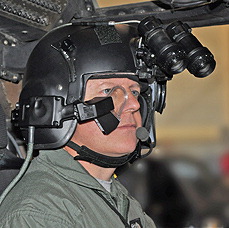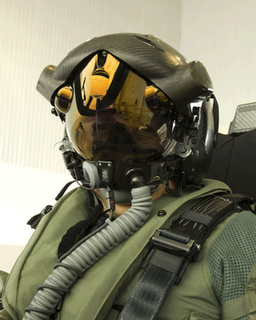

BAE Systems has been selected by Lockheed Martin to supply a Helmet Mounted Display (HMD) system for the F-35 during the next phase of its development. The new HMD incorporate the Q-Sight waveguide display and feature detachable Night Vision Goggles for night operations. BAE Systems will begin delivery of test assets in 2012 to support the F-35 development and integration laboratories, flight simulators, and flight-test platforms.
The new HMD will also incorporate an optical Head Tracking System for precise weapons delivery and carrier and land-based operations. The accurate of the optical head trackers allow the system to achieve Head-Up Display (HUD) accuracies and Primary Flight Reference criteria with free moving the helmet display.
The cockpit of the F-35 is centered around the HMD and large screen cockpit display. The aircraft has no HUD, and the two displays are interacting with multiple on-board and networked sources and sensors to provide the pilot with up-to date live situation display. The precise optics and head tracker combination enables F-35 weapons delivery, navigation, landing and aircraft management under all flight regimes. According to BAE Systems, the HMD’s modular design will allow for a path to binocular visor-projected displays, alternate image sources and Night Vision Cameras, depending on customer requirements and program needs.

The original supplier for the F-35A helmet display system was Vision Systems International (VSI) a Joint Venture between Elbit Systems and Rockwell Collins. VSI is supplying the first generation HMD to all production F-35s from 2009 up to 2012. The VSI helmet encountered some developmental problems, particularly with the integration of Distributed Aperture System (DAS), multiple infrared cameras positioned around the aircraft providing hemispherical view of the aircraft surrounding. The integration of the DAS infrared signals onto the HMD visor was supposed to provide the pilot with night vision derived from the DAS, but this solution caused problems with visual acuity and night-vision sensitivity. Lockheed Martin, the prime contractor opted to reduce the risk by opting for a near term solution based on a conventional off the shelf technology and the use of NVG when required. According to Lockheed martin, the development of the original VSI HMDS will continue under a new contract recently issued. To further mitigate risk, the alternative HMDS is not required to have binocular symbology or to display image data from the F-35’s DAS. These will be added if the BAE helmet becomes the baseline system, Lockheed Martin said.



















